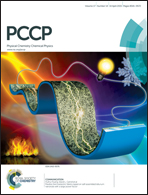Insights into the reaction mechanism of CO oxidative coupling to dimethyl oxalate over palladium: a combined DFT and IR study†
Abstract
Oxidative coupling of toxic pollutant CO to form the platform raw chemical material dimethyl oxalate (DMO) has been industrialized however the catalytic mechanism has been unknown so far. The reaction mechanism of CO oxidative coupling to form DMO on a Pd(111) surface has been investigated using density functional theory (DFT) and in situ diffuse reflectance infrared (DRIR) spectroscopy. DFT calculations and in situ DRIRS measurements indicate that two co-adsorbed intermediates COOMe and OCCO, initiate the reaction. C–C coupling occurs earlier due to a low coupling barrier and small steric hindrance. The results also suggest that Pd(111) is selective towards DMO over DMC, and that CO pre-adsorption and CO in excess effectively enhance the yield of DMO. The microscopic elucidation of this important reaction suggests improvements in coal-to-EG (CTEG) production which can be applied in practice to effectively enhance the yield and reduce the cost. The results may help with further fine-tuning and designing of high-efficient noble metal catalysts.


 Please wait while we load your content...
Please wait while we load your content...